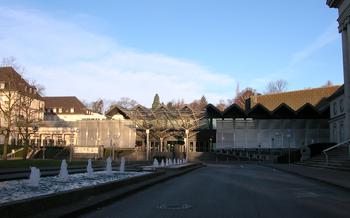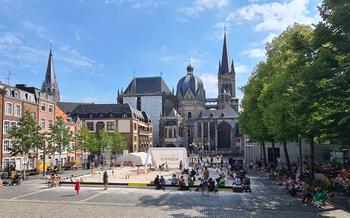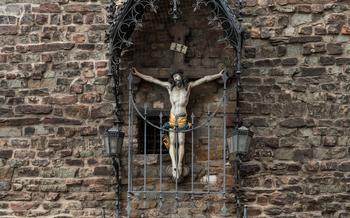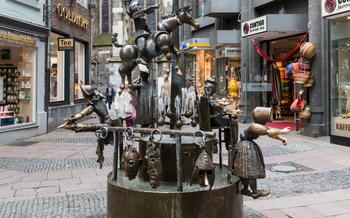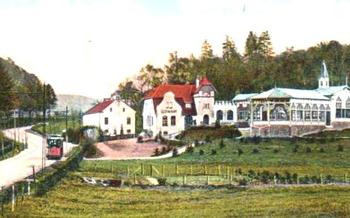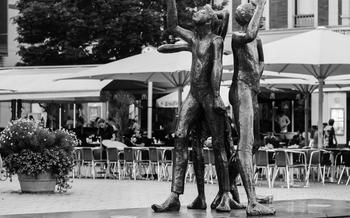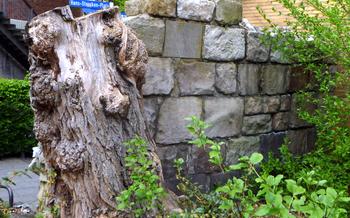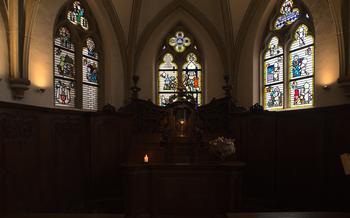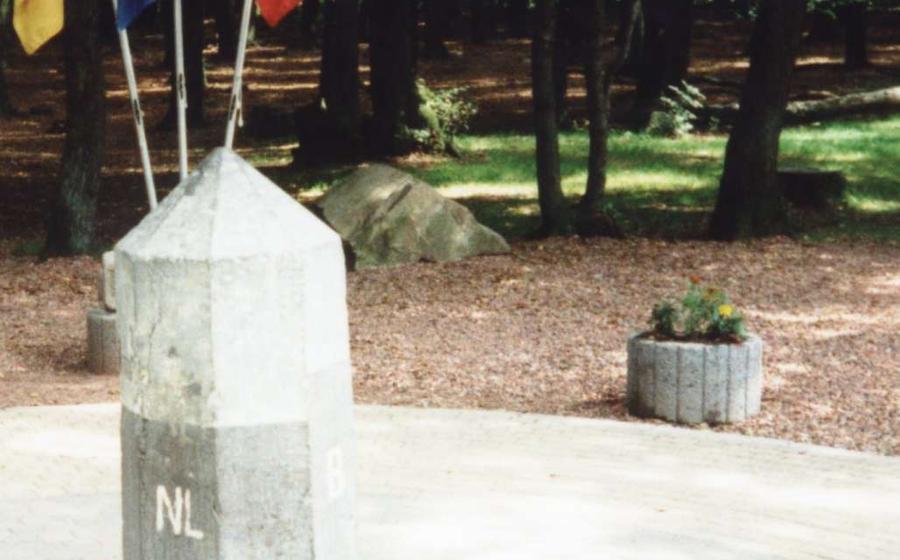
Dreiländereck Three Country Border Point
- History of the Dreiländereck
- Geographical Location
- The Three Countries
- The Three Borders Stone
- The Surrounding Area
- The Three-Country Walk
- The Three-Country Bike Tour
- The Three-Country Market
- The Three-Country Festival
- The Three-Country Lookout Tower
- The Three-Country Cafés and Restaurants:
- The Three-Country Hotels and Accommodations:
- Insider Tip: The Secret Path to the Three Borders Stone
History of the Dreiländereck
At the heart of Europe's diverse tapestry of cultures, nestled between rolling hills and tranquil valleys, lies the Dreiländereck, a unique geographical marvel where the borders of Germany, Belgium, and the Netherlands converge. This fascinating intersection of nations, steeped in historical significance, has witnessed the ebb and flow of empires, the clash of armies, and the forging of alliances.
The origins of the Dreiländereck can be traced back to the intricate web of territorial changes that shaped the European landscape over centuries. In 1815, following the Napoleonic Wars, the Congress of Vienna redrew the boundaries of Europe, establishing the modern borders of Belgium and the Netherlands. This demarcation resulted in the creation of a tri-border point where the three nations met, giving birth to the Dreiländereck as we know it today.
The Dreiländereck has served as a crossroads for people and ideas throughout history. Merchants, pilgrims, and travelers from across Europe traversed these lands, fostering cultural exchange and leaving an enduring legacy of shared heritage. The region's strategic location also made it a focal point for military campaigns, with armies vying for control of this vital juncture.
Today, the Dreiländereck stands as a symbol of unity and cooperation, a testament to the power of diplomacy and the peaceful resolution of conflicts. Visitors to this unique destination can immerse themselves in the rich history and cultural tapestry that has shaped this remarkable corner of Europe.
Geographical Location
The Dreiländereck is a unique geographical feature located in the heart of Europe, where the borders of three countries meet: Germany, Belgium, and the Netherlands. It is situated within the Euregio Maas-Rhein, a cross-border region that encompasses parts of these three countries. The exact coordinates of the Dreiländereck are 50°45'0"N 6°0'0"E. It can be found in the southernmost part of the Netherlands, in the province of Limburg, near the town of Vaals. From Maastricht, the capital of Limburg, it is a short 15-minute drive to the Dreiländereck. From Aachen, the largest city in the German state of North Rhine-Westphalia, it is approximately a 30-minute drive. From Brussels, the capital of Belgium, it is about a 1-hour and 30-minute drive.
The Three Countries
At the heart of the Dreiländereck, three distinct nations converge, each possessing a rich cultural tapestry. Germany, with its vibrant history, captivating castles, and world-renowned beer, welcomes visitors with open arms. Belgium, renowned for its delectable chocolates, surrealist art, and medieval architecture, offers a unique blend of charm and sophistication. The Netherlands, famous for its picturesque canals, windmills, and liberal spirit, invites travelers to explore its vibrant cities and serene countryside.
As these three nations converge at the Dreiländereck, a fascinating interplay of cultures unfolds. The German language, with its guttural tones and precise grammar, contrasts with the melodious Dutch and the intricate French-influenced Flemish spoken in Belgium. Traditional costumes, culinary delights, and customs vary from one country to the next, creating a kaleidoscope of cultural diversity that is both captivating and harmonious.
The Three Borders Stone
At the heart of the Dreiländereck stands a humble yet significant monument: the Three Borders Stone. This unassuming stone, embedded in the ground, marks the exact point where Germany, Belgium, and the Netherlands converge. Its weathered surface bears witness to the passage of time and the countless visitors who have come to marvel at this unique geographical oddity.
The Three Borders Stone was erected in 1843 to demarcate the boundaries between the three countries. Prior to this, the exact location of the border was a matter of dispute, leading to occasional conflicts between the neighboring states. The stone served to settle these disputes and establish a clear and permanent boundary.
Beyond its practical function, the Three Borders Stone has become a symbol of cooperation and unity among the three countries. It represents their shared history, their cultural diversity, and their commitment to peaceful coexistence. Visitors from all over the world come to see this iconic landmark, which stands as a testament to the power of cooperation and the enduring bonds between nations.
Here's a curious anecdote related to the Three Borders Stone: In 1992, a group of pranksters decided to move the stone a few meters away from its original position. They hoped to create a bit of mischief and stir up some controversy. However, their plan backfired when the local authorities quickly discovered the stone's new location and returned it to its rightful place. The incident served as a reminder of the importance of respecting borders and maintaining the status quo at the Dreiländereck.
The Surrounding Area
The Dreiländereck is surrounded by a region of natural beauty and cultural attractions. The nearby town of Vaals, located in the Netherlands, offers a variety of shops, restaurants, and cafes, as well as the Vaalsbroek Castle, a 14th-century castle that is now a hotel. Gemmenich, a village in Belgium, is home to the Gemmenich Castle, a 17th-century castle that is open to the public for tours. Eijsden, a town in the Netherlands, is known for its historic center and its many art galleries and antique shops.
In terms of activities, there are plenty of options for visitors to enjoy in the area. Hiking and cycling are popular ways to explore the surrounding countryside, with several trails and routes to choose from. The Three-Country Walk and the Three-Country Bike Tour are two popular options that take visitors through all three countries. There are also several museums in the area, including the Three-Country Point Museum, which tells the story of the history and culture of the Dreiländereck.
The Three-Country Walk
The Three-Country Walk is a popular circular hiking trail that takes visitors on a journey through all three countries that meet at the Dreiländereck. The trail is approximately 10 kilometers long and can be completed in about three hours, making it a great option for those looking for a challenging yet rewarding hike.
The trail begins in the German town of Vaals and takes hikers through a variety of landscapes, including forests, fields, and valleys. Along the way, hikers will pass by several points of interest, including the Three Borders Stone, the Three-Country Lookout Tower, and the Three-Country Playgrounds.
The Three-Country Walk is a great way to experience the natural beauty and cultural diversity of the Dreiländereck region. The trail is well-marked and easy to follow, making it a good option for hikers of all levels.
Practical Tips for Hikers:
- Start the walk early in the morning to avoid the crowds and the heat.
- Wear comfortable shoes and clothing, as the trail can be uneven in places.
- Bring plenty of water and snacks, as there are no shops or restaurants along the way.
- Be aware of the changing weather conditions, as the area is prone to sudden rain showers.
- If you are hiking with children, be sure to keep them close and supervised, as there are some steep drops along the trail.
The Three-Country Bike Tour
The Three-Country Bike Tour is an exciting cycling adventure that takes you through the picturesque landscapes of Germany, Belgium, and the Netherlands. This scenic route offers a unique opportunity to explore the diverse cultures and stunning natural beauty of these three neighboring countries.
The tour starts in the charming town of Vaals, the southernmost point of the Netherlands. From there, you'll cycle through the rolling hills of the Limburg region, passing through quaint villages and historic landmarks. As you cross the border into Belgium, you'll encounter the beautiful Ardennes Forest, with its lush greenery and winding roads. The final leg of the tour takes you through the flat polders of the Dutch province of Limburg, where you'll cycle alongside canals and windmills.
The Three-Country Bike Tour is approximately 100 kilometers long and can be completed in one or two days, depending on your pace and fitness level. The route is well-marked and mostly flat, making it suitable for cyclists of all levels. Along the way, you'll find plenty of places to stop for refreshments or to visit local attractions.
To make the most of your cycling experience, it's a good idea to rent a bike from one of the many rental shops in the area. You can also find bike-friendly accommodations along the route, where you can relax and recharge for the next day's adventure.
Whether you're an avid cyclist or simply looking for a unique and memorable way to explore the Dreiländereck, the Three-Country Bike Tour is an experience not to be missed.
The Three-Country Market
Every first Sunday of the month, the unique Three-Country Market takes place at the Dreiländereck. This vibrant market is a testament to the harmonious coexistence of the three countries and their diverse cultures. Vendors from Germany, Belgium, and the Netherlands set up their stalls, creating a colorful tapestry of goods and experiences.
The market offers a wide variety of products, from fresh produce and local delicacies to handmade crafts and souvenirs. Visitors can sample traditional dishes from all three countries, such as Belgian waffles, Dutch cheese, and German bratwurst. The air is filled with the aroma of freshly baked goods, grilled meats, and sweet treats, tempting visitors to indulge in culinary delights.
Beyond the culinary offerings, the Three-Country Market is also a celebration of cultural diversity. Visitors can find traditional clothing, jewelry, and handicrafts that reflect the unique heritage of each country. There are also live music performances, street performers, and family-friendly activities that showcase the vibrant spirit of the region.
The Three-Country Market is a wonderful opportunity to experience the unique blend of cultures that defines the Dreiländereck. It is a place where visitors can come together, celebrate their differences, and embrace the spirit of unity and cooperation that has made this region a symbol of peace and harmony.
The Three-Country Festival
A Celebration of Unity and Diversity
The Three-Country Festival is an annual event that brings together people from Germany, Belgium, and the Netherlands to celebrate their shared history and culture. Held on the second weekend of September, the festival takes place at the Dreiländereck and features a variety of activities and attractions for visitors of all ages.
One of the highlights of the festival is the traditional parade, which showcases the unique cultural heritage of each country. Visitors can enjoy performances by local dance groups, marching bands, and folk ensembles. The parade is followed by a lively party at the festival grounds, where visitors can sample delicious food and drinks from all three countries, listen to live music, and dance the night away.
In addition to the parade and party, the festival also features a variety of other attractions, such as a farmers' market, an arts and crafts fair, and a children's play area. There are also guided tours of the Three-Country Point Museum and the Three-Country Lookout Tower, as well as live music performances throughout the day.
The Three-Country Festival is a wonderful opportunity to experience the unique culture of the Dreiländereck and to celebrate the unity and diversity of the three countries that come together at this special place.
The Three-Country Lookout Tower
Standing tall at 35 meters, the Three-Country Lookout Tower is an iconic landmark and a must-visit destination for travelers to the Dreiländereck. Located in the heart of the three countries, the tower offers breathtaking panoramic views of the surrounding countryside, allowing visitors to witness the unique geographical convergence of Germany, Belgium, and the Netherlands.
The tower's strategic location provides a bird's-eye perspective of the rolling hills, lush forests, and quaint villages that characterize the region. Visitors can marvel at the intricate patchwork of fields and waterways, as well as the distant skylines of Aachen, Liège, and Maastricht, the capital cities of the three respective countries.
The Three-Country Lookout Tower is not just a vantage point but also a symbol of unity and cooperation among the three nations. Its design incorporates elements from each country, reflecting the shared history and cultural heritage of the region. The tower's viewing platform is accessible to visitors of all abilities, making it an inclusive attraction for families and individuals alike.
In addition to its panoramic views, the Three-Country Lookout Tower also houses a small exhibition that provides information about the history, geography, and culture of the three countries. Visitors can learn about the unique traditions, languages, and customs that make this region so diverse and vibrant.
For a truly unforgettable experience, visitors are encouraged to ascend the tower during sunset or sunrise. The warm hues of the sky cast a golden glow over the landscape, creating a magical and awe-inspiring spectacle. The Three-Country Lookout Tower is a symbol of unity, cooperation, and the beauty of the natural world, making it a must-visit destination for anyone exploring the Dreiländereck.
The Three-Country Cafés and Restaurants:
At the Dreiländereck, visitors are spoiled for choice when it comes to dining options. A variety of cafés and restaurants, each offering a unique culinary experience, can be found in the immediate vicinity. For those seeking a taste of German cuisine, the Café-Restaurant Zum Dreiländereck serves up traditional dishes such as schnitzel and bratwurst, accompanied by refreshing German beer. Just across the border in Belgium, the Brasserie 't Grenshuis offers a menu of Belgian classics, including moules-frites and waffles. And for a taste of the Netherlands, the Restaurant De Grens serves up Dutch specialties such as stamppot and poffertjes.
These cafés and restaurants are not just culinary destinations; they are also cultural hubs where visitors can immerse themselves in the traditions and atmosphere of each country. Whether it's enjoying a hearty German breakfast, savoring a Belgian beer at sunset, or indulging in Dutch pancakes for lunch, these establishments offer a delightful way to experience the unique flavors and hospitality of the three countries.
The Three-Country Hotels and Accommodations:
There is a wide range of accommodation options available in the vicinity of the Dreiländereck, catering to different budgets and preferences. Whether you're looking for a luxurious hotel experience, a cozy bed and breakfast, or a budget-friendly hostel, you'll find something to suit your needs.
One popular choice is the Hotel Dreiländerblick, located just a short walk from the Three Country Border Point. This modern hotel offers stunning views of the surrounding countryside and features spacious rooms, a restaurant, and a bar.
For a more traditional experience, consider staying at the Gasthof zum Deutschen Eck, a family-run inn that has been welcoming guests for over 100 years. This charming inn offers comfortable rooms, a traditional German restaurant, and a beer garden.
If you're on a tight budget, the Jugendherberge Aachen is a great option. This modern hostel offers clean and comfortable rooms, as well as a variety of amenities, including a kitchen, a lounge, and a game room.
No matter what your budget or preferences, you're sure to find the perfect place to stay near the Dreiländereck.
Insider Tip:
For a truly unique experience, consider staying at the Hotel Vaalsbroek, located just across the border in the Netherlands. This historic hotel is housed in a former monastery and offers stunning views of the surrounding countryside. Guests can enjoy a variety of amenities, including a restaurant, a bar, and a swimming pool.
Insider Tip: The Secret Path to the Three Borders Stone
For a truly unique experience, venture off the beaten path and discover the secret path that leads directly to the three borders stone. Hidden among the trees, this path offers a secluded and intimate way to reach the iconic landmark. As you follow the winding trail, keep an eye out for the subtle signs that mark the way, such as small cairns or painted stones. The path eventually leads to a clearing, where you'll find yourself standing directly in front of the three borders stone, surrounded by the serene beauty of the surrounding forest. It's a magical moment that will stay with you long after your visit.
